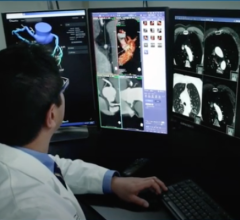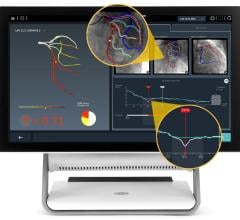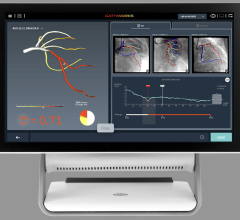
63 Percent Mortality Reduction with FFRCT-Guided Care in PAD Patients
May 8, 2024 — In a groundbreaking development, a study published in the Journal of Vascular Surgery reveals for the first time that coronary CTA (CCTA) with fractional flow reserve (FFRCT) care significantly reduces mortality by over 60 percent at five years in patients with PAD undergoing major vascular surgery, far surpassing the current standard of care.1
Atherosclerosis is a systemic disease that affects multiple vascular regions and is particularly severe in PAD patients, where up to 80 percent suffer from concurrent coronary artery disease (CAD), historically linked with a mortality rate exceeding 50 percent within five years.2-4 HeartFlow’s non-invasive FFRCT technology has emerged as a leading frontline strategy for accurately diagnosing hemodynamically significant coronary lesions in patients suspected of having CAD.5 Revascularization to improve blood flow to the heart has been shown to reduce mortality in stable chest pain patients.6
This novel study marks a significant milestone in the field, evaluating the effectiveness of FFRCT in detecting ischemia-producing coronary stenosis in patients with severe PAD. Among 522 surgical PAD patients with previously undiagnosed CAD, systematic FFRCT testing combined with targeted coronary revascularization resulted in a 63 percent reduction in all-cause mortality, an 89 percent decrease in cardiovascular death, and an 87 percent reduction in myocardial infarction during the five-year follow-up, compared to patients receiving standard cardiac evaluation.
In a groundbreaking development, a study published in the Journal of Vascular Surgery reveals for the first time that coronary CTA (CCTA) with fractional flow reserve (FFRCT) care significantly reduces mortality by over 60 percent at five years in patients with PAD undergoing major vascular surgery, far surpassing the current standard of care.1
Atherosclerosis is a systemic disease that affects multiple vascular regions and is particularly severe in PAD patients, where up to 80 percent suffer from concurrent coronary artery disease (CAD), historically linked with a mortality rate exceeding 50 percent within five years.2-4 HeartFlow’s non-invasive FFRCT technology has emerged as a leading frontline strategy for accurately diagnosing hemodynamically significant coronary lesions in patients suspected of having CAD.5 Revascularization to improve blood flow to the heart has been shown to reduce mortality in stable chest pain patients.6
This novel study marks a significant milestone in the field, evaluating the effectiveness of FFRCT in detecting ischemia-producing coronary stenosis in patients with severe PAD. Among 522 surgical PAD patients with previously undiagnosed CAD, systematic FFRCT testing combined with targeted coronary revascularization resulted in a 63 percent reduction in all-cause mortality, an 89 percent decrease in cardiovascular death, and an 87 percent reduction in myocardial infarction during the five-year follow-up, compared to patients receiving standard cardiac evaluation.
For more information: www.heartflow.com
References
1 Krievins, Dainis K., et al. “Diagnosis and treatment of ischemia-producing coronary stenoses improves 5-year survival of patients undergoing major vascular surgery.” Journal of Vascular Surgery, Mar. 2024, https://doi.org/10.1016/j.jvs.2024.02.043.
2 Halliday, Alison, and Jeroen J. Bax. “The 2017 ESC guidelines on the diagnosis and treatment of peripheral arterial diseases, in collaboration with the European Society for Vascular Surgery (ESVS).” European Journal of Vascular and Endovascular Surgery, vol. 55, no. 3, Mar. 2018, pp. 301–302, https://doi.org/10.1016/j.ejvs.2018.03.004.
3 Secemsky, Eric A., et al. “Longitudinal assessment of safety of FEMOROPOPLITEAL endovascular treatment with paclitaxel-coated devices among Medicare beneficiaries.” JAMA Internal Medicine, vol. 181, no. 8, 1 Aug. 2021, p. 1071, https://doi.org/10.1001/jamainternmed.2021.2738.
4 Bradbury, Andrew W, et al. “A vein bypass first versus a best endovascular treatment first revascularisation strategy for patients with chronic limb threatening ischaemia who required an infra-popliteal, with or without an additional more proximal infra-inguinal revascularisation procedure to restore limb perfusion (basil-2): An open-label, randomised, Multicentre, phase 3 trial.” The Lancet, vol. 401, no. 10390, May 2023, pp. 1798–1809, https://doi.org/10.1016/s0140-6736(23)00462-2.
5 Gulati, Martha, et al. “2021 AHA/ACC/ASE/Chest/Saem/SCCT/SCMR guideline for the evaluation and diagnosis of chest pain: A report of the American College of Cardiology/American Heart Association Joint Committee on Clinical Practice Guidelines.” Circulation, vol. 144, no. 22, 30 Nov. 2021, https://doi.org/10.1161/cir.0000000000001029.
6 Navarese EP, Lansky AJ, Kereiakes DJ, Kubica J, Gurbel PA, Gorog DA, et al. Cardiac mortality in patients randomised to elective coronary revascularization plus medical therapy or medical therapy alone: a systematic review and meta-analysis. Eur Heart J 2021;42:4638-4651.
7 Stanley, Gregory A., et al. “Utilization of coronary computed tomography angiography and computed tomography-derived fractional flow reserve in a critical limb-threatening ischemia cohort.” Journal of Vascular Surgery Cases, Innovations and Techniques, vol. 10, no. 2, Apr. 2024, p. 101272, https://doi.org/10.1016/j.jvscit.2023.101272.
*The HeartFlow Analysis is an AI–based medical device software for the clinical quantitative and qualitative analysis of previously acquired Computed Tomography DICOM data for patients with suspected coronary artery disease. It provides anatomic data, plaque identification and characterization, as well as the calculations of FFRCT, a coronary physiological simulation, computed from simulated pressure, velocity and blood flow information obtained from a 3D computer model generated from static coronary CT images. The HeartFlow Analysis is intended to support the risk assessment and functional evaluation of coronary artery disease.


 October 30, 2024
October 30, 2024 







